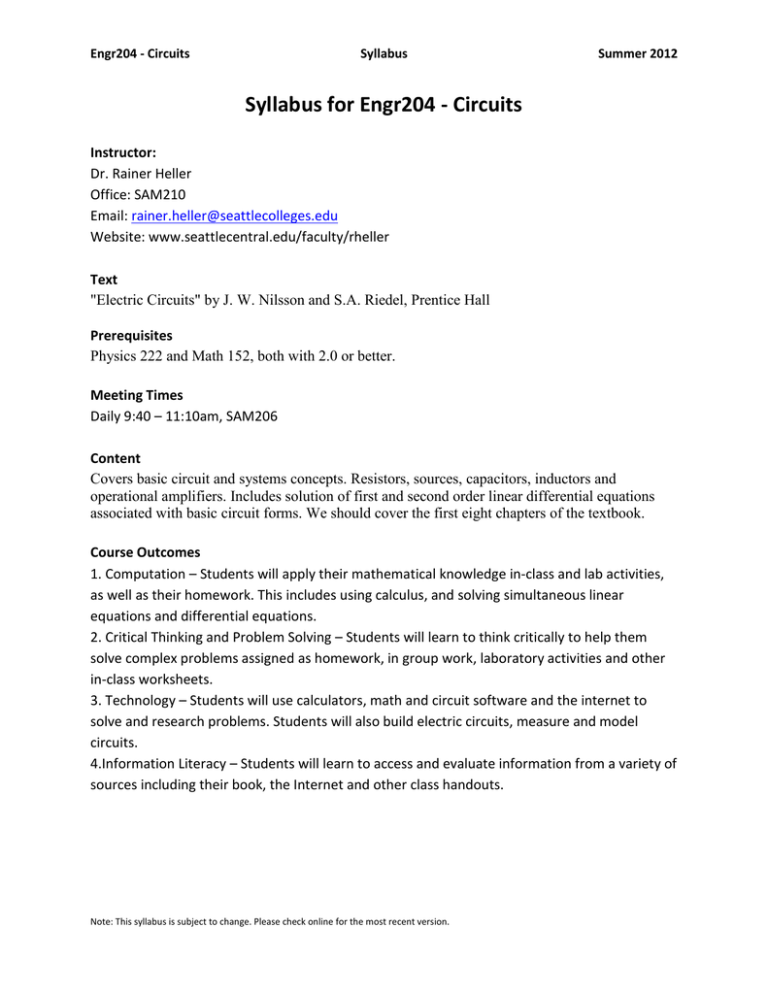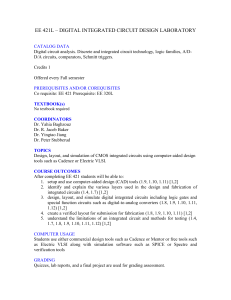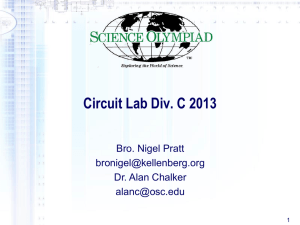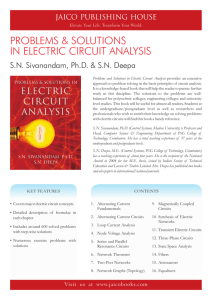Syllabus for Engr204 - Circuits
advertisement

Engr204 - Circuits Syllabus Summer 2012 Syllabus for Engr204 - Circuits Instructor: Dr. Rainer Heller Office: SAM210 Email: rainer.heller@seattlecolleges.edu Website: www.seattlecentral.edu/faculty/rheller Text "Electric Circuits" by J. W. Nilsson and S.A. Riedel, Prentice Hall Prerequisites Physics 222 and Math 152, both with 2.0 or better. Meeting Times Daily 9:40 – 11:10am, SAM206 Content Covers basic circuit and systems concepts. Resistors, sources, capacitors, inductors and operational amplifiers. Includes solution of first and second order linear differential equations associated with basic circuit forms. We should cover the first eight chapters of the textbook. Course Outcomes 1. Computation – Students will apply their mathematical knowledge in-class and lab activities, as well as their homework. This includes using calculus, and solving simultaneous linear equations and differential equations. 2. Critical Thinking and Problem Solving – Students will learn to think critically to help them solve complex problems assigned as homework, in group work, laboratory activities and other in-class worksheets. 3. Technology – Students will use calculators, math and circuit software and the internet to solve and research problems. Students will also build electric circuits, measure and model circuits. 4.Information Literacy – Students will learn to access and evaluate information from a variety of sources including their book, the Internet and other class handouts. Note: This syllabus is subject to change. Please check online for the most recent version. Engr204 - Circuits Syllabus Summer 2012 Assessment Exams: 75%. Labs: 15% Homework: 10% Exams There will 3 exams. Dates will be given as we progress through the quarter. There won't be any makeup exams. All exams count equally. Homework and Labs A set of problems from the text will be assigned on a weekly basis. These assignments are chosen to highlight the important concepts and problem solving techniques found in the chapter. There will five labs, during which you will study basic electrical circuits. Labs and homework will be group assignments. You can form groups of 2-3 students. Your lab reports and homework sets must be turned in on time. I won't accept any late homework. Solutions can be found on the website. Start working on your homework assignments as soon as we have covered the material in class. This will allow you to ask questions and work on difficult problems with others. I strongly recommend that you discuss problems with your classmates, however, your final work has to be your own, not a copy of somebody else’s work. Note that late homework may not be accepted. If it is, there will be a deduction. If you have trouble finishing your work on time please let me know ahead of time, not after the due date. Special Assistance If you need course adaptations because of a disability, if you have emergency medical information to share with me, or if you need special arrangements in case the building must be evacuated, please see me during my office hours as soon as possible. I am happy to help you in any way I possibly can. Note: This syllabus is subject to change. Please check online for the most recent version. Engr204 - Circuits Week 1 Syllabus Summer 2012 Topics Reading: Chapters 1 (Circuit variables) & 2 (Circuits elements). Reading: Chapter 3 (Simple resistive circuits) 2 Lab 1 (Introduction to Circuit Analysis) Reading: Chapter 4 (Techniques of circuit analysis) 3 4 5 6 7 8 Lab 2 (Nodal Analysis and Thevenin Equivalents) Reading: End of Chapter 4 (Techniques of circuit analysis), chapter 5 (Operational Amplifier) Lab 3 (Operational Amplifiers) Reading: End of chapter 5 (Operational Amplifier), chapter 6 (Inductance, Capacitance and Mutual Inductance) Reading: End of chapter 6 (Inductance, Capacitance and Mutual Inductance), chapter 7 (Response of first order RL and RC circuits). Lab 4 (First Order Circuits) Reading: Chapter 7 (Response of first order RL and RC circuits), chapter 8 (Natural and Step Responses of RLC circuits) Lab 5: Second Order Circuits Chapter 8 (Natural and Step Responses of RLC circuits) And let’s not forget … … to have fun Note: This syllabus is subject to change. Please check online for the most recent version.





